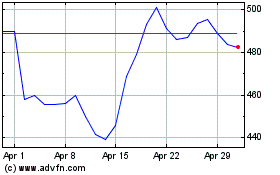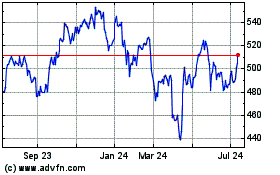Health Law Enrollment Opens Amid Volatility
November 01 2016 - 9:24AM
Dow Jones News
By Stephanie Armour and Louise Radnofsky
The fourth open enrollment for health coverage under the
Affordable Care Act opened Tuesday, a critical 90 days that the
Obama administration hopes will boost participation and stabilize
markets roiled by premium increases and insurer withdrawals.
HealthCare.gov and state equivalents began taking applications
Tuesday morning from people signing up for individual health
coverage and learning about their eligibility for subsidies. This
year is especially critical because consumers so far have been
sicker and older than expected, which has led to
higher-than-anticipated costs.
In response major insurers such as Aetna Inc. and UnitedHealth
Group Inc. have pulled back from their sales of coverage under the
law, leaving about 30% of counties with only one participating
insurer. The Obama administration said last week premiums would
increase by an average of 25% across the 38 states that use
HealthCare.gov; in many states the market leader is raising rates
by a far greater average.
Increased enrollment from younger, healthier people would create
a chance for insurers to regain their footing; without it, they
will likely reach a point of no return in which they continue to
raise rates and further deter all but the neediest of
customers.
Administration officials have a twofold goal this year. They
want to boost sign-ups of new people. They also want to attract
hundreds of thousands of people whose plans are being canceled to
come back during open enrollment to pick a new policy.
The administration is banking on television ads, direct mail and
targeted outreach in cities with a high number of younger adults to
help boost sign-ups. About 10.7 million people who are eligible for
exchange coverage are still uninsured, according to Health and
Human Services. Forty percent of them are 18 to 34 years old.
Around the country, enrollment activists are preparing to help
people who have coverage shop around for plans that can shield them
from premium increases or replace plans that have been canceled.
Open enrollment Tuesday was to include events where consumers can
get help signing up or attend informational sessions in places like
the library in Edina, Minn. and a kickoff event at a sports stadium
in Las Vegas.
Community groups have been at the forefront of the sign-up drive
since the law launched in fall 2013, at first because the
administration had limited resources for outreach work, and later
because research has indicated they are the most effective at doing
it. But official funding for such efforts remains scant and
insurance brokers have seen their commissions for signing up people
diminish, further cutting into the ranks of those working on the
sign-up effort.
Federal officials say they have found new and more efficient
ways to reach uninsured people, including, for example, joint
efforts with public agencies, such as Philadelphia Gas Works and
the Chicago Housing Authority, to contact users about enrollment
deadlines.
But they are making these efforts in the final stretch of the
election season in which Republican candidates up and down the
ticket have been rallying around the premium increases as a sign of
the law's failure. The issue has provided a late and unifying boost
to GOP nominees from presidential candidate Donald Trump to
incumbent senators such as John McCain in Arizona .
Democratic nominee Hillary Clinton has largely talked about the
need for changes to the law, as an alternative to repealing it.
Open enrollment runs through Jan. 31, 11 days into the new
president's administration. Individuals who lost coverage due to
the cancellation of a plan will be considered eligible for a
special enrollment that lets them sign up for coverage as late as
March 1.
An estimated 13.8 million people are expected to have selected a
plan by the end of open enrollment, an increase of 1.1 million
compared with the end of 2016 open enrollment.
"This year, the vast majority of consumers will qualify for tax
credits that help keep coverage affordable, and it's easier than
ever to shop around and compare options," said Health and Human
Services Secretary Sylvia Burwell. "As we sound today's opening
bell, let's also take stock of the historic gains in coverage we've
made as a country, and work together to continue that
progress."
Write to Stephanie Armour at stephanie.armour@wsj.com and Louise
Radnofsky at louise.radnofsky@wsj.com
(END) Dow Jones Newswires
November 01, 2016 09:09 ET (13:09 GMT)
Copyright (c) 2016 Dow Jones & Company, Inc.
UnitedHealth (NYSE:UNH)
Historical Stock Chart
From Mar 2024 to Apr 2024

UnitedHealth (NYSE:UNH)
Historical Stock Chart
From Apr 2023 to Apr 2024
